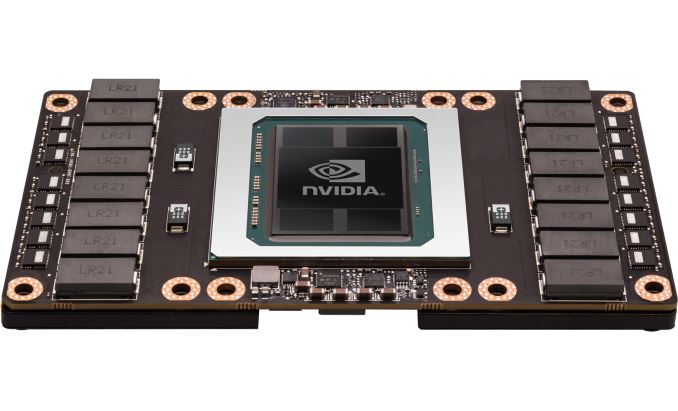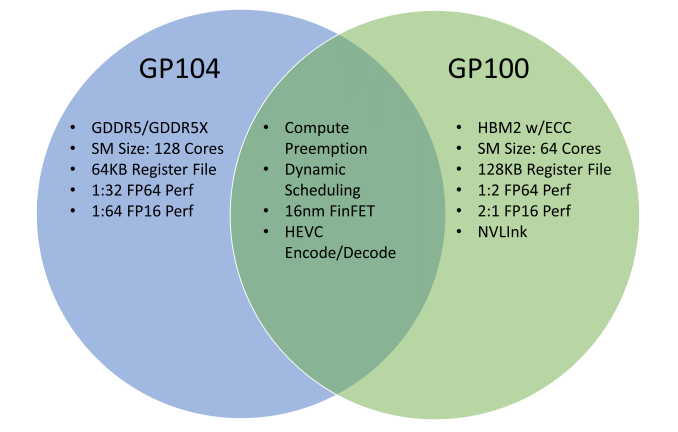The NVIDIA GeForce GTX 1080 & GTX 1070 Founders Editions Review: Kicking Off the FinFET Generation
by Ryan Smith on July 20, 2016 8:45 AM ESTPascal’s Architecture: What Follows Maxwell
With the launch of a new generation of GPUs we’ll start things off where we always do: the architecture.
Discrete GPUs occupy an interesting space when it comes to the relationship between architecture and manufacturing processes. Whereas CPUs have architecture and manufacturing process decoupled – leading to Intel’s aptly named (former) tick-tock design methodology – GPUs have aligned architectures with manufacturing processes, with a new architecture premiering alongside a new process. Or rather, GPU traditionally did. Maxwell threw a necessary spanner into all of this, and in its own way Pascal follows this break from tradition.
As the follow-up to their Kepler architecture, with Maxwell NVIDIA introduced a significantly altered architecture, one that broke a lot of assumptions Kepler earlier made and in the process vaulted NVIDIA far forward on energy efficiency. What made Maxwell especially important from a development perspective is that it came not on a new manufacturing process, but rather on the same 28nm process used for Kepler two years earlier, and this is something NVIDIA had never done before. With the 20nm planar process proving unsuitable for GPUs and only barely suitable for SoCs – the leakage from planar transistors this small was just too high – NVIDIA had to go forward with 28nm for another two years. It would come down to their architecture team to make the best of the situation and come up with a way to bring a generational increase in performance without the traditional process node shrink.
Now in 2016 we finally have new manufacturing nodes with the 14nm/16nm FinFET processes, giving GPU manufacturers a long-awaited (and much needed) opportunity to bring down power consumption and reduce chip size through improved manufacturing technology. The fact that it has taken an extra two years to get here, and what NVIDIA did in the interim with Maxwell, has opened up a lot of questions about what would follow for NVIDIA. The GPU development process is not so binary or straightforward that NVIDIA designed Maxwell solely because they were going to be stuck on the 28nm process – NVIDIA would have done Maxwell either way – but it certainly was good timing to have such a major architectural update fall when it did.
So how does NVIDIA follow-up on Maxwell then? The answer comes in Pascal, NVIDIA’s first architecture for the FinFET generation. Designed to be built on TSMC’s 16nm process, Pascal is the latest and the greatest, and like every architecture before it is intended to further push the envelope on GPU performance, and ultimately push the envelope on the true bottleneck for GPU performance, energy efficiency.
HPC vs. Consumer: Divergence
Pascal is an architecture that I’m not sure has any real parallel on a historical basis. And a big part of that is because to different groups within NVIDIA, Pascal means different things and brings different things, despite the shared architecture. On the one side is the consumer market, which is looking for a faster still successor to what Maxwell delivered in 2014 and 2015. Meanwhile on the high performance compute side, Pascal is the long-awaited update to the Kepler architecture (Maxwell never had an HPC part), combining the lessons of Maxwell with the specific needs of the HPC market.
The result is that there’s an interesting divergence going on between the HPC side and its GP100 GPU, and the consumer side and the GP104 GPU underlying GTX 1080. Even as far back as Fermi there was a distinct line separating HPC-class GPUs (GF100) from consumer/general compute GPUs (GF104), but with Pascal this divergence is wider than ever before. Ultimately the HPC market and GP100 is beyond the scope of this article and I’ll pick it up in detail another time, but because NVIDIA announced GP100 before GP104, it does require a bit of addressing to help sort out what’s going on and what NVIDA’s design goals were with GP104.
Pascal as an overarching architecture contains a number of new features, however not all of those features are present in all SKUs. If you were to draw a Venn diagram of Pascal, what you would find is that the largest collection of features are found in GP100, whereas GP104, like the previous Maxwell architecture before it, is stripped down for speed and efficiency. As a result while GP100 has some notable feature/design elements for HPC – things such faster FP64 & FP16 performance, ECC, and significantly greater amounts of shared memory and register file capacity per CUDA core – these elements aren’t present in GP104 (and presumably, future Pascal consumer-focused GPUs).
Ultimately what we’re seeing in this divergence is a greater level of customization between NVIDIA’s HPC and consumer markets. The HPC side of NVIDIA is finally growing up, and it’s growing fast. The long term plan at NVIDIA has been to push GPU technology beyond consumer and professional graphics, and while it has taken years longer than NVIDIA originally wanted, thanks in big part to success in the deep learning market, NVIDIA is finally achieving their goals.
This means that although GP100 is a fully graphics capable GPU, it doesn’t necessarily have to be put into video cards to make sense for NVIDIA to manufacture, and as a result NVIDIA can make it even more compute focused than prior-generation parts like GK110 and GF110. And that in turn means that although this divergence is driven by the needs of the HPC market – what features need to be added to make a GPU more suitable for HPC use cases – from the perspective of the consumer market there is a tendency to perceive that consumer parts are falling behind. Especially with how GP100 and GP104’s SMs are differently partitioned.
This is a subject I’ll revisit in much greater detail in the future when we focus on GP100. But for now, especially for the dozen of you who’ve emailed over the past month asking about why the two are so different, the short answer is that the market needs for HPC are different from graphics, and the difference in how GP100 and GP104 are partitioned reflect this. GP100 and GP104 are both unequivocally Pascal, but GP100 gets smaller SM partitions in order to increase the number of registers and the amount of shared memory available per CUDA core. Shared memory and register contention on graphics workloads isn’t nearly as great as with HPC tasks – pixel shader threads are relatively short and independent from each other – which means that while the increased ratios benefit HPC workloads, for graphics the gains would be minimal. And the costs to power and die space would, in turn, far outweigh any benefits.














200 Comments
View All Comments
jcardel - Wednesday, July 27, 2016 - link
This is excactly the same situation as me. I got a 770 sitting in my rig, and am looking hard at the 1070, maybe soon. Although my 770 is still up to the task in most games, I really play only blizzard games theese days and they are not hard on your hardware.My biggest issue is really that it is rather noisy, so I will be looking for a solution with the lowest DB.
Great article, it was totally worth waiting for.. I only read this sort of stuff here so have been waiting till now for any 1080 review.
Thanks!
D. Lister - Thursday, July 21, 2016 - link
Nice job, Ryan. Good comeback. Keep it up.Saeid92 - Thursday, July 21, 2016 - link
What is 99th procentile framerate?Ryan Smith - Thursday, July 21, 2016 - link
If you sorted the framerate from highest to lowest, this would be the framerate of the slowest 1%. It's basically a more accurate/meaningful metric for minimum frame rates.Eris_Floralia - Thursday, July 21, 2016 - link
This is why I love Anandtech. Deep in reviews. Well I even wanted to be one of your editors if you have the plan to create a Chinese transtate version of these reviews.daku123 - Thursday, July 21, 2016 - link
Typo on FP16 Throughput page. In second paragraph, it should be Tegra X1 (not Tesla X1?).Ryan Smith - Thursday, July 21, 2016 - link
Eyup. Thanks!Badelhas - Thursday, July 21, 2016 - link
Great detailed review, as always. But I have to ask once again:why didnt you do some kind of VR Benchmarks? Thats what drives my choises now, to be honest.
Cheers
Ranger1065 - Thursday, July 21, 2016 - link
After over 2 months of reading GTX1080 reviews I felt a distinct lack of excitementas I read Anandtech kicking off their review of the finfet generation. Could it
prove to be anything but an anticlimax?
Sadly and unsurprisingly...NOT.
It was however amusing to see the faithfull positively gushing praises for Anandtech
now that the "greatly anticipated" review is finally out.
Yes folks, 20 or so pages of (well written) information, mostly already covered by other tech sites,
finally published, it's as if a magic wand has been waved, the information has been presented with
that special Anandtech sauce, new insights have been illuminated and all is well in Anandtechland again.
(AT LEAST UNTIL THE NEXT 2 MONTH DELAY.) LOL.
I do like the way Anandtech presents the FPS charts.
Back to sleep now Anandtech :)
mkaibear - Thursday, July 21, 2016 - link
You've hit the nail on the head here Ranger.The info which is included within the article is indeed mostly already covered by other tech sites.
Emphasis on the "mostly" and the plural "sites".
Those of us who have jobs which keep us busy and have an interest in this sort of thing often don't have the time to trawl round many different sites to get reviews and pertinent technical data so we rely upon those sites which we trust to produce in-depth articles, even if they take a bit longer.
As an IT Manager for (most recently) a manufacturing firm and then a school, I don't care about bleeding edge, get the new stuff as soon as it comes out, I care about getting the right stuff, and a two month delay to get a proper review is absolutely fine. If I need quick benchmarks I'll use someone like Hexus or HardOCP but to get a deep dive into the architecture so I can justify purchases to the Art and Media departments, or the programers is essential. You don't get that anywhere else.